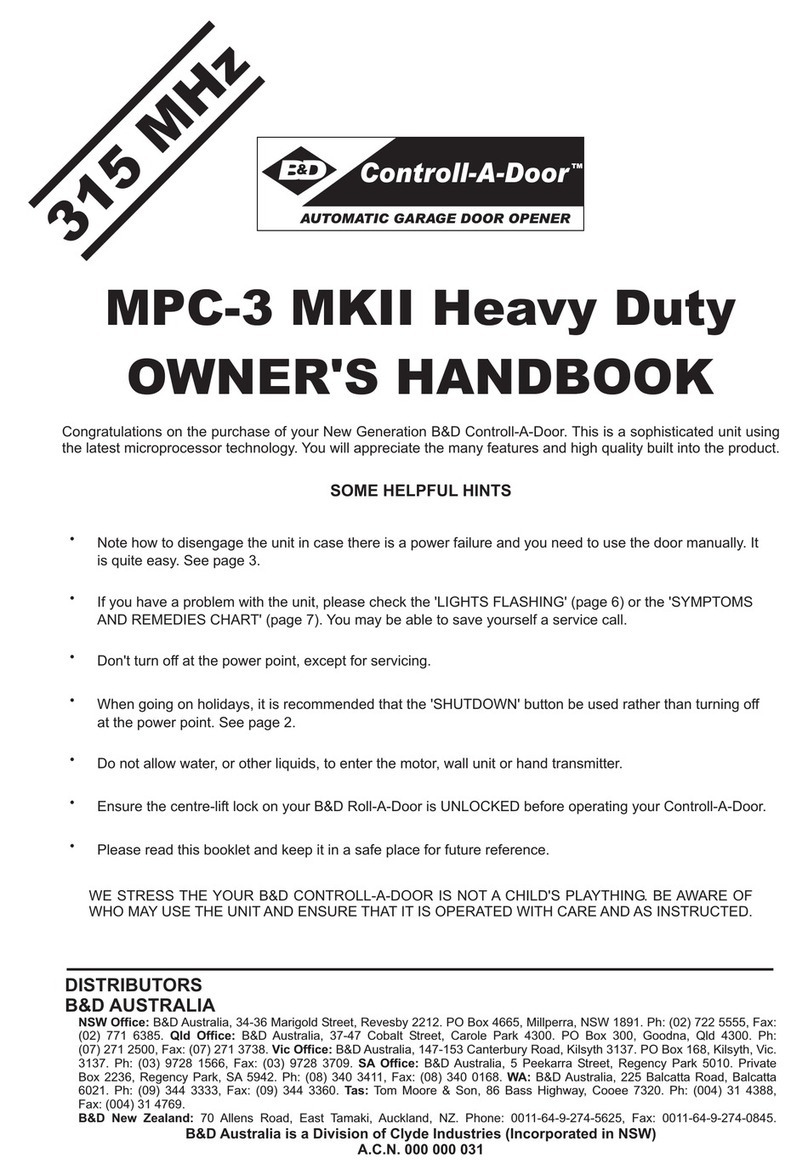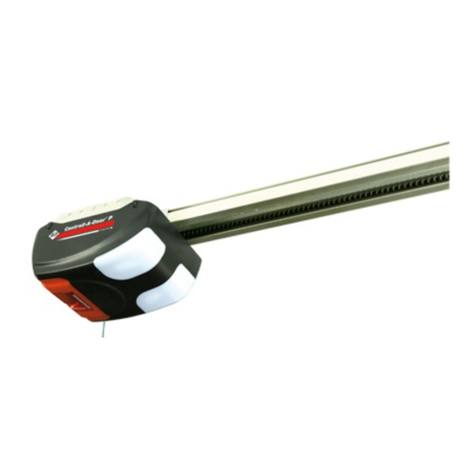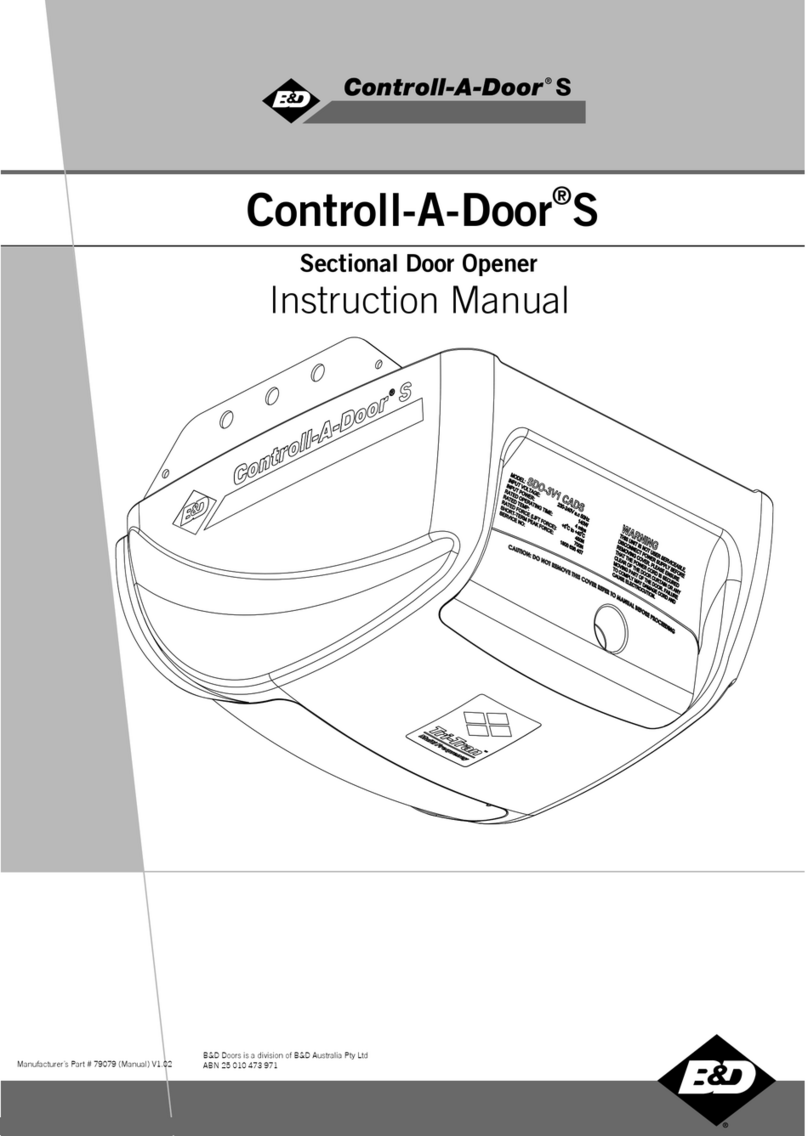Installation
a. Check the door’s operation. The door must travel smoothly and be easy to operate
by hand.
b. Operating force on the bottom rail should be approximately 70N (7kgs) force
c. Adjust any tight or twisted guides/tracks Clean the guides if there is any oil or wax
present using a suitable white spirit. The only lubricant suitable for use on door
guides is silicon spray. DO NOT use WD-40, RP-7, petroleum grease, or similar.
d. Install the locking bar covers 2 if there are locking bar holes in the guides.
e. Affix the warning labels supplied with this opener in a prominent place where they
are clearly visible.
f. Choose the side where the opener will be installed, ensuring there is sufficient
sideroom.
WARNING! - Do not lock your door with the locking bars after installing the
opener. Remove or disable the lock using wire or cable ties. Security is not
affected as the opener has an inbuilt locking facility.
If the door has a handle
WARNING! The door and its springs are under significant tension.
Adjustments should only be carried out by experienced persons, as this
function can be dangerous if not performed under strict safety procedures.
a. Remove the door handle
b. Fit the weight bar 5 and refit the handle using the new fasteners 6 7 8
provided.
If the door does not have a handle
a. Locate the centre of the door at the bottom rail.
b. Place the weight bar 5 at this point (there is a
centreline marked on the weight bar) and mark the
two positions where the fasteners will go.
c. Drill the two 4.5mm holes in the door and fit the weight
bar using the new fasteners 6 7 8 provided.
a. Fully close the door.
b. Mark drill two (2) holes in the valley of the curtain at both ends of the door into the
drum.
c. Drill holes using 3.2mm (1/8”) drill bit. Open the door slightly for easier access, if
necessary.
d. Fit two (2) M10 x 32mm screws 9 and washers 10 . Each screw should be positioned
as low as possible, within the valley, but make sure that it does not alter the curtain’s
normal approach to the guide (lead-in angle).
e. At the end opposite to where the opener will be fitted, check that the U-bolt is
tightened securely. Open the door completely and tie safety ropes around the door roll
approximately 300mm from each end. Do not tie the ropes too tight as damage to the
curtain may ensue.
f. At the end where the opener is to be fitted, support the door with a door stand or
suitable ladder.
g. Use masking tape or pen to mark the position of the U-bolt in the door bracket and the
position of the door bracket on the wall to assist in reassembling.
h. Remove the U-bolt (or bolts) and saddle from the door bracket.
i. Remove the door bracket allowing the door to rest on the support.
Door drum
U-bolt
Mark position
of U-bolt on the
bracket and bracket
on the wall.
Drill Holes
NOTE: Check that the door is
still balanced and smooth to
operate. If it is not, then the
door may require servicing
(refer to door manufacturer’s
instructions).
NOTE: For minimum sideroom installations the
door may have to be taken down.
Door
Stand
2 x 9 and 10
Safety rope
Door
Bracket
NOTE: Make sure that the screws do not
project into the area where the internal
gear will fit.
WARNING! Make sure the support is
snug under the door, stable and will not
move.
90°
Mounting the Opener
Pull string
handle if gear
is not turning
freely
Release
Safety Rope
Remove Door
Stand
Refit Door
Bracket
Tighten
“U-Bolt”
nuts
CAUTION - If the manual release handle is more than 1.8 metres
from floor level when the opener is installed, extend the handle to a
height less than 1.8 metres.
WARNING! Use caution when operating the manual relase with the
door open since it may fall rapidly due to weak or broken springs, or
an improperly balanced door.
Ensure that no persons or objects are in the door’s path.
Setting the Close Limit
Move the door to half way open. If necessary, disengage the opener by pulling
the red handle down.
a. Re-engage the opener by pulling the red handle down.
b. Turn on the power to the opener. The CLOSE LIMIT LED will be flashing.
c. Press and hold the MINUS (-) button - the door should starting closing.
d. If the door opens, release the MINUS (-) button and press the OPERATE
button once to change the motor’s direction. Press the MINUS (-) button
again to close the door.
e. Release the MINUS (-) button when the door is near the desired closed
position. Single presses of the MINUS (-) button will “inch” the door closed.
f. If the door overshoots press the PLUS (+) button to move the door in the
open direction.
g. When the door is at the desired close position, press the LIMIT SET button
to record the Close limit position.
Setting the Open Limit
a. The OPEN LIMIT LED will now flash.
b. Press and hold the PLUS (+) button to open the door
c. Release the PLUS (+) button when the door is near the desired open position.
Single presses of the PLUS (+) button will “inch” the door open.
i. if the door overshoots press the MINUS (-) button to move the door in
the CLOSE direction.
WARNING! The door will automatically close, open and close again
once the next step is performed.
Ensure that no persons or objects are in the door’s path.
d. Press the LIMIT SET button to store the open limit. Please read the above
warning.
Resetting the Door Limit Positions
To reset the limits press and hold the Limit Set button for 6 seconds until the Close
Limit LED flashes quickly. If no action is taken within 30 seconds, the opener will
return to normal operating mode and restore the original limit settings.
Button 1
(Inch Open)
Button 4
(Inch Close)
Button 2
(Set)
Programming the Opener
Proceed to Programming
the Opener
Coding Transmitters
Button 1
Proceed to Mounting
the Opener
f. Re-attach the door bracket using your reference marks as a guide and tighten the bolts.
Ensure that the slots in the mounting bracket of the opener align with the slots in the
door bracket, otherwise the door bracket may have to be relocated.
NOTE: If the bracket cannot be relocated, the opener may be fitted onto the axle using the
opener’s saddle and U-bolt as follows:
i. Using your reference marks as a guide, sit the opener on the door mounting
bracket and secure with the opener’s U-bolt and saddle and tighten firmly.
ii. Adjust the door position (if necessary) on the brackets so that the door feeds
smoothly into the guides. Make sure that the centre of the door doesn’t hit
the lintel and that the curtain is not pushed forward hard into the guide.
c. Remove the Door stand and safety ropes
d. Connect the power cord to a suitable power point, but DO NOT SWITCH ON. Secure
the power cord away from any moving object (e.g. the door) with the cable clip supplied.
e. With the opener still disengaged, pull the door up and down to make sure it runs freely.
Leave the door approximately in the middle of travel and engage the opener.
Accessories
Auxiliary Output
The auxiliary output can be used to control alarm or another garage
door opener. A valid transmission from the pre-coded transmitter
will cause the auxiliary output to pulse for approximately 1 (one)
second. The maximum DC voltage must not exceed 35 volts DC.
Maximum current must not exceed 80 ma.
Storing the Transmitter Code
The opener can only operated from remote control transmitters that have been programmed
into its memory. Up to 64 codes (RDO-1V3) or 8 codes (Firmamatic) can be stored in the memory.
a. Ensure that the battery is inserted in the transmitter.
b. Press the CODE SET button and release. The CODE SET LED will illuminate to indicate the
opener is in Code Learn mode. If a valid code is not stored within 15 seconds the opener will
exit Code Learn.
c. Press the transmitter button (one of four) that you want to control the door. The CODE SET
LED will flash.
d. Press the same transmitter button again. The CODE SET LED will illuminate for one second
then go out.
e. The transmitter button is now coded - press to test.
Coding a Transmitter to the Courtesy Light
The transmitter can be programmed to operate the courtesy light on the opener independently
of the door moving.
a. Press the CODE SET button twice - the CODE SET LED and courtesy light will both illuminate.
b. Press one of the four buttons on the transmitter for two (2) seconds, pause for two (2) seconds,
then press the same button again for two (2) seconds.The CODE SET LED will illuminate for
one second then go out.
c. Press the transmitter button to test.
Coding a Transmitter Button to Enable Vacation Mode
The opener can be programmed into a “Vacation Mode” where the opener will not respond to
any transmitter except the button of the transmitter that was programmed for vacation mode.
a. Press the CODE SET button three (3) times - the CODE SET LED will illuminate and the
courtesy light will flash slowly.
b. Press one of the four (4) buttons on the transmitter for two (2) seconds, the CODE SET LED
will begin to flash, pause for two (2) seconds, then press the same button again for two (2)
seconds.
c. The CODE SET LED will illuminate for one second and then go out, and the courtesy light
will also switch off. This indicates the code has been stored.
d. Press and hold the transmitter button for five (5) seconds to set Vacation Mode. The CODE
SET LED will stay lit while Vacation Mode is active.
e. To reset Vacation Mode, press the same button for two seconds, until the CODE SET LED
turns off.
Coding a Transmitter to enable AUX Output
a. Press the CODE SET button four (4) times - the CODE SET LED will illuminate and the
courtesy light will flash quickly.
b. Press one of the four (4) buttons on the transmitter for two (2) seconds, the CODE SET LED
will begin to flash, pause for two (2) seconds, then press the same button again for two (2)
seconds. The CODE SET LED will illuminate for one second then go out.
c. Press the transmitter button to test.
Setting the Transmitter to Operate PET (Pedestrian) Mode
The PET mode position (see Programming the Opener) must set prior to coding a transmitter.
a. Press the CODE SET button five (5) times - the CODE SET LED will illuminate and the
courtesy light will flash quicky (twice per second).
b. Press one of the four (4) buttons on the transmitter for two (2) seconds, the CODE SET LED
will begin to flash, pause for two (2) seconds, then press the same button again for two (2)
seconds.
c. The CODE SET LED will illuminate for one second and then go out, and the courtesy light
will also switch off. This indicates the code has been stored.
d. Press the transmitter button to test.
Proceed to Safety
Obstruction Force
2
5
8
6
7
8
5
6
7
V+
EB1
0V
EB2
0V
OSC
AUX
External device,
Alarm, Door or
Gate opener.
V+
EB1
0V
EB2
0V
OSC
AUX
Reset all Factory Defaults
a. Turn power to the opener off.
b. Press and hold the LIMIT SET Button.
c. Turn power on while holding the LIMIT SET button.
Continue to hold until all LED’s are off.
d. This will not erase transmitter codes stored in memory.
Remote Aerial
Some sites cause poor radio reception. Particularly problematic areas are
those where there is a large amount of metal, like a steel garage, or an
underground car park with large masses of steel reinforced concrete. These
issues, and others, can create reception issues.
Poor radio reception will be noticed by a reduction in the operating range
of the transmitters.
You can evaluate whether fitting an external aerial will benefit as follows;
i. Test the maximum operating range of the transmitter with the
garage door closed; then
ii. Test the maximum operating range of the transmitter with the
garage door open.
If the range improves when the door is open you can install a remote aerial
kit to improve reception.
Mount the aerial to a suitable location on the outside of the garage.
Similar to a television aerial, the better the mounting position the better
the reception will be. Where possible, mount the aerial as high as possible,
away from masses of metal and in line of sight position, to where you
normally use your transmitter.
WARNING! In setting the close limit position, do not
force the door into the floor with excessive force, as this
can interfere with the ease of operation of the manual
release mechanism.
a. Insert the two (2) Extension forks 11
into the ring gear.
b. Secure with two (2) Flat washers 12
and two (2) Hex serration head screws
13 .
c. If the internal gear does not rotate
freely, switch the opener to manual
by pulling the disengagement handle
down (there will be a click), so that the
ring gear can be rotated by hand.
d. Slide the opener over the door axle
and into the drum of the door.
e. Ensure the internal gear is pushed in
as far as possible (without interfering
with the door curtain) and that one
of the door drum’s wheel spokes is
completely between the opener’s
drive forks.
Keyswitch Connection
The RDO-1V3 has the input to connect bell switch or keyswitch to
open or close the door.
11
12
13
Proceed to Coding
Transmitters
Proceed to Accessories
IMPORTANT NOTE: Only Tri-Tran+
Technology Transmitters are compatible
with this RDO-1V3 product.
TB-6 Shown
TB-6 Shown
Setting the PET Mode position
When activated, PET mode drives the door to the preset position
from the close position.
a. Drive and stop the door at the deisred PET mode open position
by pressing the transmitter button coded for Open/Stop/Close
operation.
b. Press and hold the PLUS (+) button on the opener for six (6)
seconds until the OPEN and CLOSE LED’s are lit to record the new
PET position.
c. Release the PLUS (+) button.
34-36 Marigold St, Revesby, NSW, Australia ABN 25 010 473 971
P: 13 62 63 W: www.bnd.com.au
TB-6 Shown
Option not
available
with the TB-5
transmitters
(Firmamatic)
Erasing Programmed Codes
If the CODE SET button is pressend and
held for six (6) seconds the CODE SET LED
will blink rapidly for one second to indicate
that all programmed codes have been
erased.
Installation of the Wall Mounted Transmitter
a. Mount the transmitter in a convenient location, yet out of reach of children and at least
1.5m off the ground.
b. Make sure the door is visible from this location.
c. To set the transmitter press the CODE SET button and release. The CODE SET LED will
illuminate to indicate the opener is in Code Learn mode. If a valid code is not stored within
15 seconds the opener will exit Code Learn.
d. Press the transmitter button (one of four) that you want to control the door. The CODE SET
LED will flash.
e. Press the same transmitter button again. The CODE SET LED will illuminate for one second
then go out.
f. The transmitter button is now coded - press to test
Remotely Coding Transmitters
Using this method transmitters can be coded without access to the opener’s control panel as
long as a pre-coded transmitter is available.
a. Take any pre-coded transmitter. Press the button for the function to be duplicated and
release.
b. Using a small needle / pen, press and hold firmly for two seconds the middle button, through
the Coding Hole.
c. Within ten (10) seconds take the additional transmitter you wish to code. Hold the new
transmitter’s button for two seconds, pause for two seconds, hold again for two seconds and
then release.
d. Wait for ten (10) seconds and then press the new transmitter’s button to test.






















